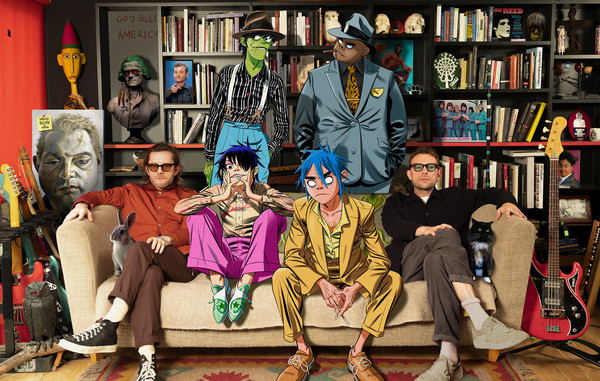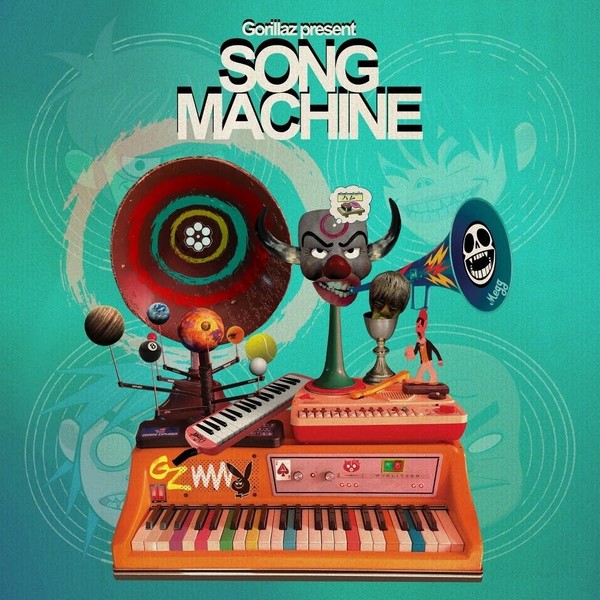I have always had a hard time introducing people to Gorillaz’s work. As a rule, the interest in my friend’s eyes rapidly fades into a fathomless blankness as I go on with the list of loosely-related genres and influences, and eventually, I am forced to withdraw in defeat. However, it is hardly ever my fault. In the two decades since the release of the band’s debut album, Gorillaz’s music and aesthetics have kept evolving, defying any attempt at classification. They sound like everything you ever listened to and, at the same time, nothing you have heard before; they deconstruct genres and reconstruct them into a totally new, unique sound. I cannot think of any other artist who could incorporate an orchestra, a children's choir, and a rap performance in one song and make a huge hit out of it, as they had in their song “Dirty Harry”.
Ironically, with all the frankness and emotional resonance of its music, the band is not even “real” in the physical sense — its members are cartoons. The Gorillaz project was born as an act of rebellion against shallow entertainment and manufactured rockstars by artist Jamie Hewlett and musician Damon Albarn. As Albarn explains, “We’re the generation whose stars come from Pop Idol and celebrity-wrestling shows. And it's all a bit like a cartoon, really.” Looking at the pop culture of today, it seems like the idea behind Gorillaz is as topical as ever. The band might not exist in the physical world, but it definitely has a presence in it.

In January, Gorillaz announced the start of their Song Machine project. The project was conceived as a series of monthly stand-alone singles and music videos — aka “episodes” — which would be created on the go and without the limitations of a strict concept that usually accompany the creation of an album. In retrospect, it seems like the band’s decision to take an unconventional approach with their seventh studio album release has foreshadowed the significant changes the world would go through this year. One can see that there could not be a better year to start this project after reading the half-joking comment from Remi Kabaka Jr., the band’s drummer: “It’s more interesting working in the episodic format because it’s easier to respond to a moment than trying to remember your response to the moment. You are a bulletin — a responder in the moment, not a reporter of the moment.” Well, with so many things going on in the world this year, the band had a lot to respond to.
Eventually, the free-standing songs released throughout the year were pieced together into Song Machine, Season One: Strange Timez, and I believe it is one of the band’s most outstanding works so far. Despite not being forged under a single concept, the tracks make a cohesive whole together. All the songs were created in collaboration with a number of guest artists, and the list is as diverse as it has ever been on a Gorillaz project.
The collaboration that generated the most buzz in the media was 6LACK, a Grammy-nominated hip-hop artist, and Elton John on “The Pink Phantom”. Skeptical upon the release of the song, I was genuinely surprised by how well their voices flow together. “The Pink Phantom” sounds like what might have been a sentimental ballad on its own, but it was infused with electronic and R&B elements, creating an eerie, mysterious vibe. The psychedelic effect is reinforced by a music video featuring 6LACK as a hologram and animated Elton John playing the piano in his pink suit.
“Pac-Man” is something fans are most familiar with, possessing all the features of their previous hits: a sharp beat, some synthwave elements, vocals from 2-D, and a rap feature. However, for this album, the tracks I enjoyed the most were not characteristically Gorillaz. Particularly, “Momentary Bliss”, released as the first episode of the series in January, became my 2020 anthem. The song is an emotional rollercoaster, from a melancholic intro with the soothing vocals of Slaves’ Isaac Holman, to punky rap parts from British hip-hop artist slowthai. For me, this song is very symbolic. The intro perfectly describes the state of melancholic uncertainty I often experienced this year, and the immense difference in sounds communicates how unpredictable the world has been recently. The lyrics can be interpreted as a criticism of the way we indulge ourselves in the “momentary bliss” of going out and not wearing masks, failing to see the bigger picture. The world “could do so much better than this”. At the same time, the upbeat nature of the song reminds me to keep my chin up and keep going.
Overall, I see Strange Timez as a musical representation of the period in history it was released, both how it was put together and its content. Strange Timez is about isolation, the feeling of confusion in the once-familiar world that is changing so fast that no long-term solutions seem to work to solve its problems — but we keep going, one song decision at a time.


